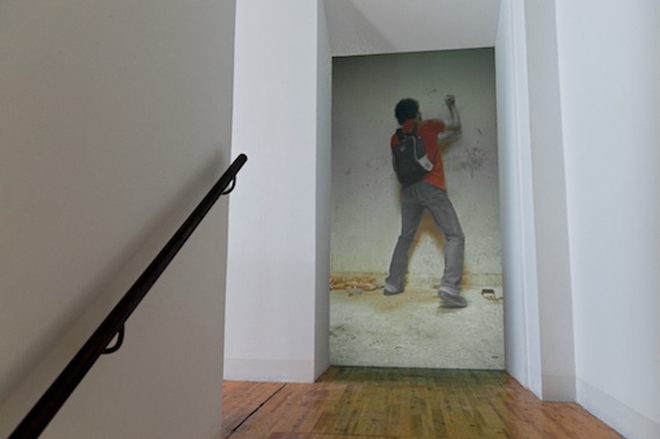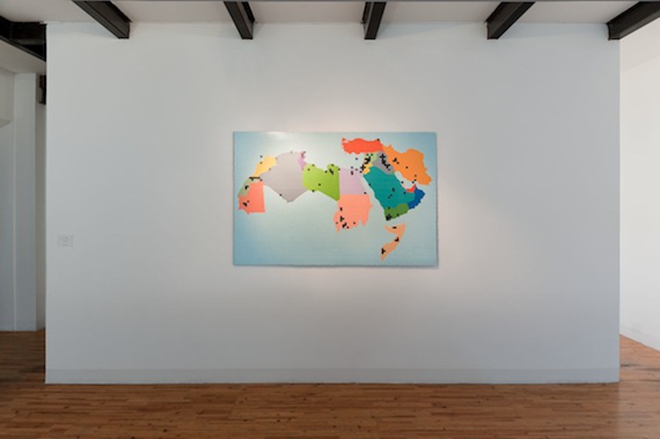Moataz Nasr at Galleria Continua
“The Tunnel,” solo exhibition by Moataz Nasr.
Galleria Continua (#8503, Dashanzi 798 Art Factory, 2 Jiuxianqiao Road, Chaoyang, Beijing). Mar 24–Aug 19, 2012.
You enter through the penguins, a crowd of inflatable riot police, walk past the cute-kitsch porcelain figurines, including police assaulting a woman (“Cairo Walk”2006), past the restaurant-neon military badges that have taken flight (“Falcons” 2012) — and there against the back wall stands a striking white pyramid. Atop its precarious steps, giant wings await: you become an angel — an Egyptian eagle. An attendant takes a photo to record your ascent, which is then added to the collection at the foot of the pyramid, forming collective wings, with each photo a feather. It is a transcendental play, transforming us mortals into immortals and making material the moral question, “Where do you stand?”
Egyptian artist Moataz Nasr’s exhibition “The Tunnel” at Galleria Continua in Beijing presents circus fun tempered with critical resonance. Nasr is an artist who speaks directly and forcefully for a civil society. The exhibition is sometimes blunt, sometimes eloquent, but above all timely. The badges that have taken flight are “Eagle Gamal [Abdul Nasser] 2012” and “Falcon Anwar [El Sadat] 2012,” referencing two reformist Egyptian presidents of recent history, the latter assassinated in 1981 by an army of religious fundamentalists. The badges address Egypt’s conflicted contemporary moment, wrestling modernity and faith, democracy and military rule. Elsewhere, a 1:1 video shows a young man repeatedly kicking a concrete wall, attempting to knock it down (“The Wall” 2012), its meaning ambiguous because unlike its Berlin counterpart, this wall remains standing. The lions that guard Qasr al-Nil Bridge in Cairo have a bandage over one eye — hurt but not blind, still resolute. Meanwhile Nasr’s renowned videos of colorful Sufi dervishes spinning bring a more reflective tone, as do the re-workings of traditional symbols as pictures composed of colored matches that are set on fire (“Nesr” 2012 and “Khayameya” 2012).

“墙”, 影像, 1分34秒, 循环播放, 2012
The highpoint of “The Tunnel,” though, is Nasr’s dual-channel video, “The Echo” (1933-2003), in which excerpts from famous old Egyptian movies are played simultaneously with new counterparts in which a woman repeats the dialog word-for-word. Nothing changes. Imagine the cavernous warehouse of Galleria Continua empty but for these films playing alone at the top of the tower. The exhibition would have been just as successful.

“丢失的部分(冰淇淋地图)2008-2012″, 拼图, 180 x 120 cm, 2012